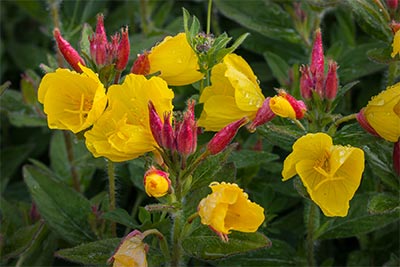Evening Primrose
- Scientific Name: Oenothera biennis
- Garden: Beneficial Insects and Compost Garden
- Plant Type: Herbaceous Biennial
- Evergreen/Deciduous: Evergreen
- Sun/Shade Exposure: Full Sun
- Moisture Requirements: Moist, Well-Drained
Plant Information
Easily grown in average, medium moisture, well-drained soils in full sun. Tolerates some part afternoon shade and some drought. Grows well in gravelly or sandy soils. May spread in the landscape by self-seeding in a somewhat weedy fashion. In the first year, this biennial typically produces a basal rosette of shallow-toothed, lanceolate, light green to olive green leaves (to 4-8” long and 2” wide) but no flowers. In the second year, a stiffly-upright, rough-hairy, purple-tinged flower stem (usually a single stem but sometimes multiple stems) with spirally arranged leaves rises from the center of the rosette to 3-5’ tall, topped by a showy summer to fall (June to September) bloom of bowl-shaped, four-petaled, lemon yellow flowers (each to 1-2” across). Flowers bloom in a multi-flowered terminal panicle and, if present, in panicles at the tips of major stems, with a single flower blooming at the base of upper leaf-like bracts. Flowers open at dusk and close again in the morning when hit by sun, hence the common name of evening primrose. Flowers are fertilized by night-flying moths which are attracted by the mild lemon flower fragrance and by bees in the early morning before closure. Each flower has 4 petals, 4 reflexed sepals, 8 stamens and a prominent style with a cross-shaped stigma. Fruits are capsules (narrow seed pods to 1 1/2” long) which split open when ripe to release numerous seeds (to 100 seeds per capsule). Plants die after setting seed but will remain in the landscape through self-seeding. No serious insect or disease problems. Leaf spot and powdery mildew may occur.
Data Source
https://www.missouribotanicalgarden.orgPlant Photos



